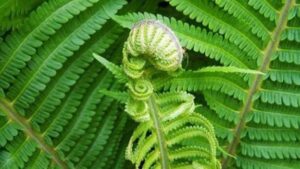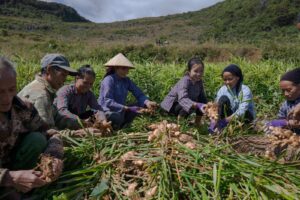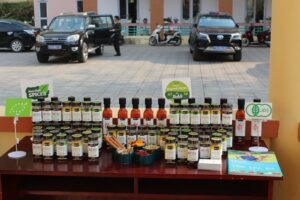Identify models for regenerative production of Cinnamon cassia and star anise in Cao Bang, Vietnam
Project: Regional Biotrade II Submit to Representative Office in Vietnam
Ha Noi, 2024
ACKNOWLEDGMENT
Adviser would like to thank the staff of HELVETAS Vietnam Office: Mrs. Nguyen Dieu Chi, Regional Project Vice Manager, Mr. Jos van der Zanden, Regional Project Manager for their enthusiastic support in the process. Adviser would also like to express our sincere thanks to agencies and officials at HELVETAS Swiss Intercooperation Representative Office in Vietnam for their help in providing the necessary information to carry out the task.
Finally, Adviser would like to thank DACE manager and staffs spent time to support this task.
This report was conducted in Mid August 2024 with funding from the Regional BioTrade Programme II in Hanoi. During the field survey to conduct the action, Adviser received dedicated support from the Regional BioTrade Programme II in Hanoi both in terms of organization, logistics, funding, related references as well as connection with DACE and related local agencies and organizations. Adviser also received enthusiastic support from the the Regional BioTrade Programme II.
In particular, Adviser received support from Mrs. Nguyen Dieu Chi – Regional Project Vice Manager and officers at the HELVETAS Vietnam Office. Through this, Consultant would like to sincerely thank for those valuable help.
This report could not be completed without mentioning the enthusiastic support from the community, local people, People’s Committees of Van Trinh, Duc Long, Duc Thong communes – Thach An – Cao Bang during consultation and field data collection. Especially, the participation and support of DACE staffs. Adviser sincerely thanks for this valuable help and effective cooperation.
Sincerely thank!
1. INTRODUCTION
1.1. Background
Vietnam has diverse and abundant natural resources of non-timber forest products (NTFPs), occupying an important position in the country’s socio-economic life. According to statistics, at present, there are about 200 spice tree species, many of which are precious, associated with the survival and use of forest-based communities. For a long time, trees for spice are the main source of livelihood of mountainous people, contributing to poverty alleviation, food security, social stability and environmental protection in mountainous areas in our country. In particular, cinnamom and star anise tree is a type of NTFP for spice, a source of high-value raw materials, has many different uses, used in households and industry, indispensable in many industries. Cinnamom bark and star anise fruit is used as spice. Their oil is also processed into cosmetics.
In recent years, with the trend of healthy, safe, socially responsible, ecological and sustainable environment, using natural materials instead of chemical compounds is the most common trend. In developed countries, the demand for products from cinnamom and star anise products tends to increase. A number of enterprises processing products from cinnamom and star anise tree began to recover and tended to develop, attracting a labor force in rural areas. On the other hand, along with the trend of globalization, the strengthening of international economic integration, the exchange and sale of goods on foreign markets has enriched the categories and rapidly increased the demand for products with high quality natural biological origin, creating important economic opportunities for businesses, households, individuals and craft villages producing and trading products of natural biological origin, including natural biological products grown from cinnamom and star anise tree, contributing to improving people’s lives and changing the face of the economy in some localities..
According to the Vietnam Forestry Development Strategy for the period 2021-2030, with a vision to 2050 approved by the Prime Minister in Decision 523/QD-TTg dated April 1, 2021, the State will support households forest protection and development to develop NTFP production, production of forestry biological products, supporting industries for forest product processing, support building forest product value chains and reorganization concentrated production areas in the direction of developing key products suitable to the advantages of each region, including developing NTFP production in the direction of commodity production, and rationally using planted protection forests in the direction of both ensure the protection function and provide raw materials for production.
According to research documents and practice in many countries around the world, cinnamom and star anise are 2 mainly NTFP spicies, distributed mainly in China and some Asian countries. In Vietnam, cinnamom and star anise are 2 native trees, widely distributed from North to South, can grow and develop well in Thach An district, Cao Bang province. Cinnamom and star anise trees are a large, perennial tree that grows and develops quite quickly, the time for harvesting products is about 7- 8 years, early generating income and continuously for growers. Cinnamom and star anise trees are 2 large tree with a wide canopy and has a very good protective effect, so it is classified as one of the main forestry tree species. The main product is to get the fruit, bark and oil so when harvesting the fruit, bark with the right technique, it has little effect on the protection function of the forest. Therefore, cinnamom and star anise trees are considered 2 key NTFP trees with high economic value, playing an important role in greening bare land, protecting forests, and providing income to help people improving lives, helping the local economic development as well as hunger eradication and poverty reduction, so in many provinces and cities across the country such as Yen Bai, Lao Cai, Cao Bang, Lang Son, Quang Ninh local authorities and communities. has paid great attention to investing in the development of this species. However, due to the fact that it has only recovered in recent years, knowledge about this species are still limited, especially information about suitable growing conditions.
Regional Biotrade II is a four-year project (September 2020-August 2024) funded by the Government of Switzerland through the State Secretariat for Economic Affairs (SECO). The program follows a previous phase which ran from September 2016 to September 2020. The goal of the project is the conservation of biodiversity through sustainable trade of biodiversity products in a manner that integrates local exporters/producers into global value chains and increases income for the rural population women and men that depend on biodiversity resources for their livelihoods in the Mekong region.
The new phase of the program includes three country components covering the core target countries of Myanmar, Vietnam, and Laos, and a regional component covering light-touch intervention in Cambodia and partnerships with regional and international companies and organizations. HELVETAS Swiss Intercooperation has overall management responsibility, and directly manages the Laos, Myanmar, and Regional components, while Vietnamese NGO CRED manages the implementation of the Vietnam component.
The Regional Biotrade II project is working with DACE company to promote sustainable cinnamon and star annis production in Cao Bang province. We have identified some risks to biodiversity that the current cultivation practices are posing. These are:
- The invasion of low quality cinnamon and star annis variation to the province: Cao Bang cinnamon is different from cinnamon grown in the main production areas of Yen Bai and Lao Cai – primarily because Cao Bang cinnamon has smaller, narrow leaves. Whether it is a different species of Cinnamonum (possibly loureiroi) or simply a different variety of Cinnamonum cassia, careful testing has shown that it has very low levels of coumarin – less than 0.001 mg/g as opposed to levels reaching 4 – 6 mg/g in regular C. cassia. This is significant due to health scares over the potentially carcinogenic properties of coumarin, and makes Cao Bang cinnamon particularly attractive to European buyers, who aim to achieve full compliance to food. To obtain premium prices from the European market, it is important that farmers continue to grow local, narrow-leaved cinnamon. From the perspective of biodiversity, it is also important that this genetic variation is preserved.
- Monoculture, high-density farming, and the practice of cutting down trees for harvesting are degrading soil, reducing genetic diversity, and plants’ natural resilience.
- Pests are increasingly problematic with observations of star anise trees affected by diseases that reduce productivity.
- Changing climatic conditions – higher temperatures and longer dry seasons – seem to impact plant health but there is no clear understanding of this.
In such a context, to support DACE company and the local producers to understand:
- The importance of preserving Cao Bang cinnamon genetic variation
- The causes behind the risks described above.
It becomes very necessary and important.
1.2. Goal
The objective of this action is to provide technical support to DACE and small local producers to identify models for regenerative production of Cinnamon cassia, and star anise in Cao Bang province, Vietnam
2. SPECIFIC TASKS
Specific research tasks include:
Cinnamon cassia
In the case of Cinnamon cassia, the core of the expert work would be to support UEBT local biodiversity staff in:
Understanding the main varieties used in the fields and the most suitable combinations.
Identify native spices with strong roots that can adapt to the hard soil in the current cinnamon plantation forests in Thanh An district.
Exploring best locations for interplanting models of native spices into Cinnamon cassia forest considering changing climatic conditions among others
Exploring possible harvesting techniques that avoid bare soil or actions to compensate in case of no harvest alternative viable.
Explain the pros and cons of each of the models described below.
Cinnamon cassia is planted with other forest plants: it is planted under the canopy of natural forests, especially with timbers & bamboo. Cinnamon cassia is planted with a density of 2000-3000/ha. When Cinnamon cassia is 3-4 years old, people “slowly kill” the high trees to give space for Cinnamon cassia.
Cinnamon cassia is planted with agricultural crops (mainly hilly rice, corn, and cassava..). This model uses land & agricultural crops to shade young Cinnamon cassia.
Cinnamon cassia is planted in family gardens with fruit trees. In this model, Cinnamon cassia grows fast because it is provided with enough nutrients and care.
Cinnamon cassia is planted in a more “diversified landscape” where local tree species are planted along streams and ponds to provide shelter for birds and other important species.
Understanding which of the models would suit the reality of the farmers working with DACE most and increases the biodiversity on their farms but at the same time help to adapt the models to the contexts where those farmers work and keep their income stable.
Star Anise
In the case of star anise, the core of the expert work would be to support DACE staff in
Understanding the issues affecting star anise cultivation, root causes, and most suitable solution
Understanding the main varieties used in the fields and the most suitable combinations.
Exploring best locations for star anise fields considering changing climatic conditions among others
Understanding main farm management practices (e.g. seed selection and sourcing, sowing, soil, weed, and pest management, irrigation, harvest, etc.) and possible improvements.
Explaining the pros and cons of each of the models described below
monoculture under poor forests, recovering forests, or open space with regenerative timber trees.
agroforestry (with tea, ginger, turmeric…) on production forests.
scattering in family gardens, around the house, or intercropped with fruit trees
Understanding which of the models would suit the reality of the farmers working with DACE most and increase the biodiversity on their farms but at the same time help to adapt the models to the contexts where those farmers work and keep their income stable.
3. SUBJECTS AND SCOPE OF research
– Target audiences: cinnamom and star anise distributed in Thach An – Cao Bang.
– Scope of research:
+ About space: in order to meet the objectives, within the framework of funding, limited time, on the basis of the requirements of the contract, consultants will conduct investigations and collect information at 3 communes: Van Trinh, Duc Long, Duc Thong – Thach An – Cao Bang.
+ About time: 15 days (From June to August, 2024)
4. METHOD OF IMPLEMENTATION
To obtain sufficient information, some methods are applied as follows:
- Desk work – data digitalization, analysis, the conceptualization of biodiversity-friendly models, and reporting.
- Fieldwork: analysis of different production areas, the definition of observation sites per area, observation of Cinnamon cassia, star anise, and other vegetation (e.g. tree density per hectare, diameter class distribution, crown vitally, related vegetation: main species and description of densities & diameter per layer (understory, canopy, emerging trees) and photographic documentation; setting up & monitoring the model tests. The field visits were conducted in 3 communes in Thach An districts (Van Trinh, Duc Long, Duc Thong). The field visits aimed at gathering information on current farming practices, relevant regulations and community rules, understanding of key actors around the production of cassia and star anise, management and conditions of sample sites, collect samples to identify the genetic varieties and test product quality. The field visits included:
- Interviews with key informants (e.g. producers, traders, farmers, local authorities)
- Visit and data collection in sample plots.
- Laboratory analysis: use NTFP Laboratory to analysis products quality and the DNA techniques to identify the genetic varieties of cinamon and star annis in Cao Bang.
- Using GIS and informatics technology to analyze data (Mapinfor, Excel, SPSS, …)


